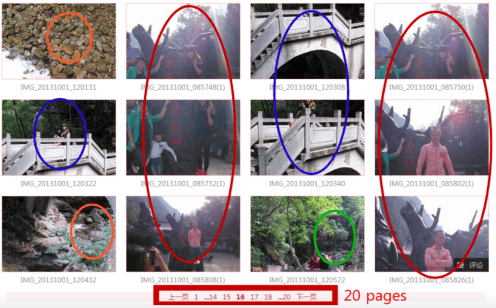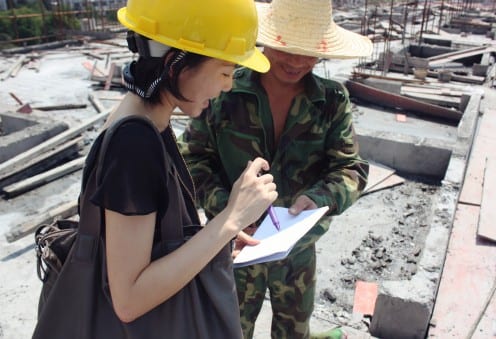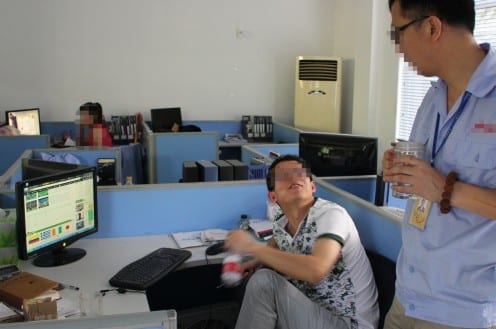It’s not just about Chinese migrant workers
By Xin Yuan Wang, on 22 June 2015

Chinese female migrant workers working in a local reflective vest workshop. Photo by Xinyuan Wang
A question always strikes me as I write up ethnography and prepare for talks based on my 15 months of fieldwork among Chinese factory workers in southeastern China: what will people learn from Chinese migrant workers’ use of social media? Of course these stories may sound ‘exotic’, but I will see it as a total failure if they are nothing more than novel and exotic in peoples’ eyes.
Ethnography in a way is a storytelling of others’ lives. This technique is also widely used in novel writing, film making, and all forms of the narrative of ‘otherness’. Recently a film came out called Still Alice, a touching film telling the story of an extremely intelligent female linguistic, Alice, in her 50s who suffers from Alzheimer’s. In the film Alice is not only gradually losing all of the professional knowledge she acquired after many years of education and research, but also all the memories of her life, of being a mother, a wife, a woman, even a human being. My colleagues and friends who watched the film shared the same thought, how lucky we are to still have those memories which, from time to time, we take for granted. And some of them, including myself, even became a bit panicked when we would forget something all of the sudden – OMG, is that an early sign of Alzheimer’s?! Whether being grateful, thoughtful, or even panicked, all of these reactions come from the fact that we are placing ourselves in the story and imagining ourselves living her life. Empathy is the word we use to describe these experiences that bridge other’s stories and our own.
And ‘empathy’ is key for the ethnographer. I still recall the days when I felt desperate about the state of my filedwork, that I had nothing to do but watch ‘stupid’ videos on people’s smartphones with the factory workers or just stare at people’s repetitive movements on the assembly line for hours. All the boredom drove me bananas and I howled to Danny that I couldn’t bear such a dreadful life anymore. What Danny said not only calmed me down but also woke me up: “Don’t forget, if you have enough, you can easily walk out in the near future, but for them, it’s their whole life.”
The most unforgettable thing I learned from my fieldwork was not the material I took away for my research, but the personal experience of being able to live those migrant workers’ lives. Through this experience I developed an empathetic respect for other people’s lives and motivations which, in turn, has allowed me to reflect upon, and be grateful for, my own life. However, not everybody has the ‘luxury’ to experience others’ lives like ethnographers do. This further highlights the importance of our research, that we have the opportunity to bring an empathetic understanding of ‘others’ to the public when they read or listen to our research.
People constantly gain knowledge of themselves through understanding others: how we are different from the others, how we are similar to the others, why we are different or similar, these inquiries help us to depict the outline of the ‘self’. This is the main reason for the importance of learning other’s stories, because they allow us to gain perspective on our own lives, to think and feel differently. A good novel or a good film achieves this, so why not ethnography? One could argue that ethnography can do this even better, given its holistic knowledge of the given population and society.
The empathy and thought evoked from an anthropological study of ‘others’ can be very powerful, one of the most famous cases comes from Margaret Mead’s fieldwork in Samoa. Mead’s book Coming of Age in Samoa has sparked years of ongoing and intense debate on various issues such as society, community, social norms, and gender. For example, Mead described how gender is constructed by the local community, in this case one totally different from American society, and argued that masculine and feminine characteristics are based mostly on cultural conditioning. This argument actually influenced the 1960s ‘sexual revolution’ when people in the West started to rethink gender.That’s the real strength of ethnography.
This bares a question for all anthropologists, in what way is your research relevant to an audience who may not necessarily be interested in the specific group or society that is the focus of your research? The knowledge drawn from fieldwork should not be parochial. As we can see in Mead’s case, ethnography about a group of people which seems to bear very limited relevance to people in the West is capable of inspiring people by evoking reflection of the ‘self’, culture, and society.
In some of my talks, as well as at the end of the ethnography I am writing, I always try to remind people that it is not just about Chinese rural migrants. Yes, they are the human faces behind ‘Made in China’, they are said to be part of the biggest migration in human history. However, it is more than that. For example, understanding the ways migrant workers experience social media as the place where real daily life takes place in the context of their appalling offline situation pushes us to think about the complex relationship between online and offline, which is one of the core issues about social media use worldwide. The fantasy images on the social media profiles of Chinese rural migrants may look totally bizarre to you, but the logic of applying imagination to guide, explain, fulfill or strike a balance in daily life is as old as human history – dreams, sexual fantasy, folktale, religion…you name it. So a study of how people play out their fantasies about life with the help of social media and how such experiences impacts people’s lives may not just be relevant in that given population and society. It is not just about Chinese rural migrants, it’s about understanding them as well as gaining understanding of ourselves.
 Close
Close













